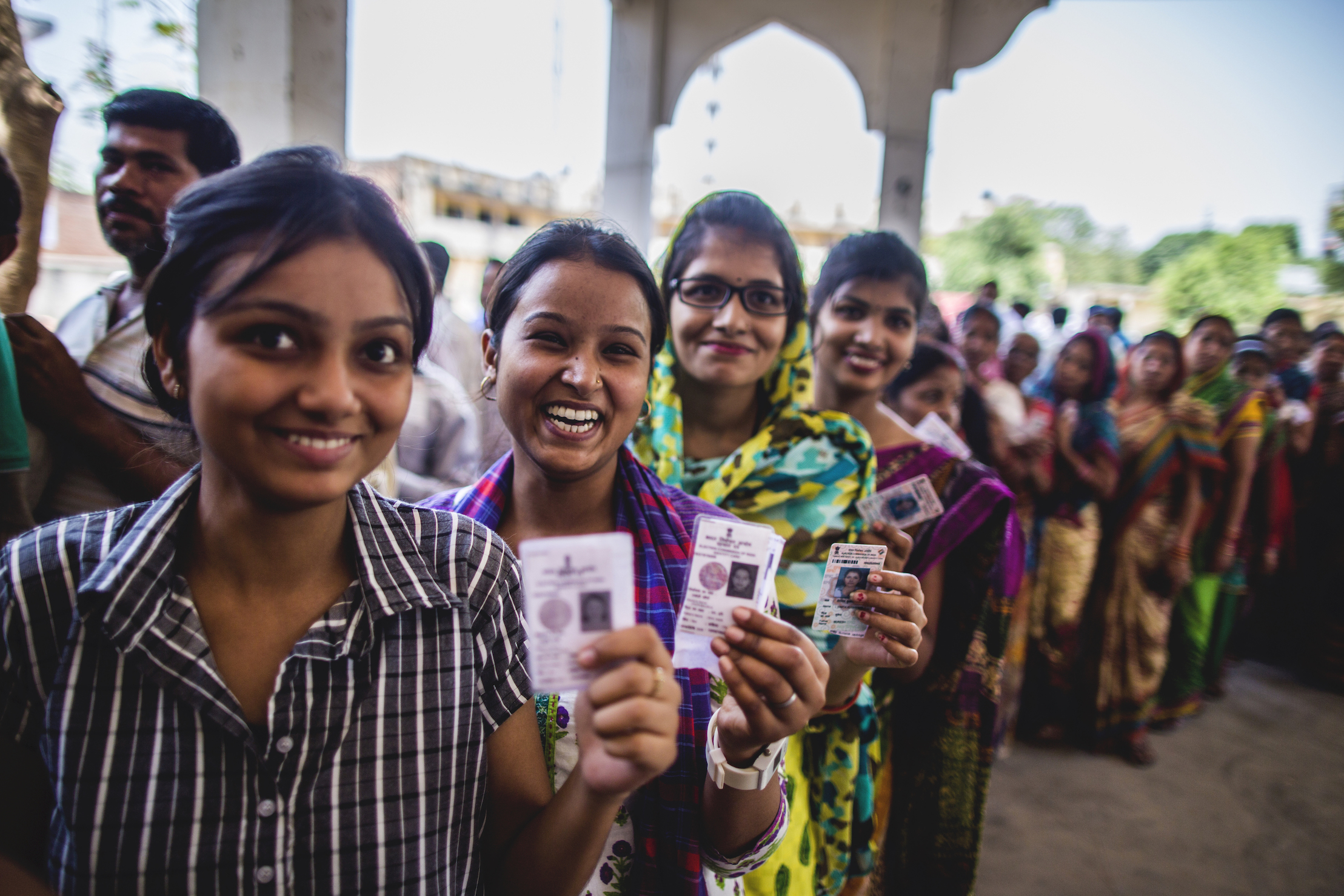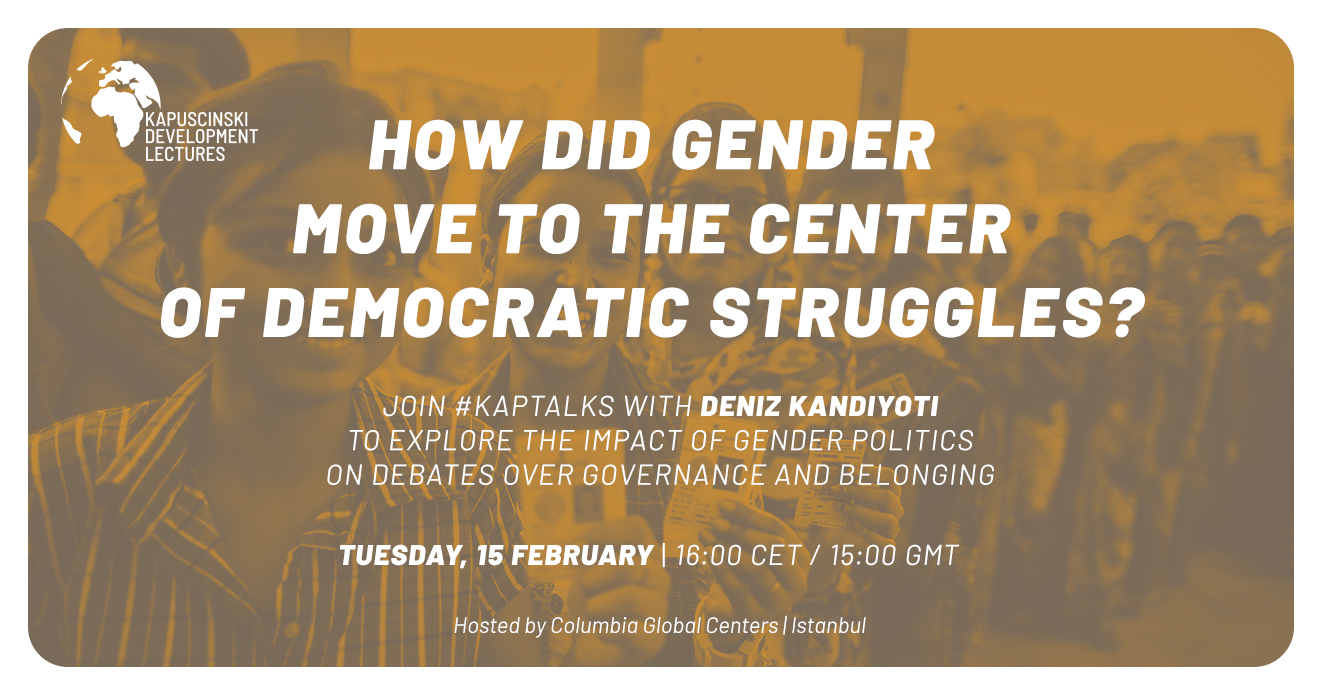Voters stand in a queue to vote at a local polling station in Varanasi, India. Photo: UNDP India/Prashanth Vishwanathan.
Emeritus professor Deniz Kandiyoti has been researching and teaching gender and development studies for over 50 years, as well as working with the UN system. In advance of her Kapuscinski Development Lecture on “How did gender move to the center of democratic struggles?”, she spoke on the intersections of gender and politics and the changes she’s seen.
Women's rights and gender equality platforms can only have a global resonance if they are in tune with democratic struggles, which are not only about gender issues but about governance more generally. This is the moment when gender must insert itself into anti-authoritarian struggles everywhere. And I think that sociologically speaking, this is an opportune moment, since we are witnessing both cross-gender alliances of men and women resisting autocratic regimes and awareness of the meaning of anti-gender politics. The time has come to abolish any walls between the politics of gender and politics, pure and simple.
We've been witnessing serious alliances of anti-gender groups all around the world. In light of these ideologies across geographies and religions, how do you see the current challenges for women's rights movements and their potential future?
The anti-gender movement is not of very recent origin. Already in the 1990s, there was a concerted effort to discredit the idea of gender as socially-constructed and to establish that gender relations are not a matter of civic debate or human rights but of doctrinal or cultural imperatives. This came to a head by the 1995 International Women’s Conference in Beijing where the term gender was officially adopted by UN agencies and the donor community, alongside tools such as gender mainstreaming, gender analysis and gender training.
When I look back at the 1970s and ‘80s, the focus was explicitly on women's rights and women's marginalization in the development process. By the time we got to the mid-90s, this discourse had shifted in complex ways. On the one hand, you had development theorists and practitioners who, critiquing the limitations of the women and development approach, introduced gender as a relational concept. To do development work, you needed to take into account relations between men, women and different generations, as well as class, caste, ethnicity and race.
Meanwhile, in academia, post-structuralist scholars introduced another meaning of gender as fluid, abolishing the sex/gender distinction and presenting sexuality itself as a construct. This coincided with sexual liberties platforms and LGBTQI rights advocates becoming more vocal and effective in social movements of the north. In many countries of the south, this created conundrums for women’s rights activists whose basic citizenship rights were still unaddressed. Thus, a stubborn gap in the language, means and temporalities of women's rights struggles in the north and the south remained, both in civic space and in the development sphere.
So what does this imply and how does it relate to the present? Essentially, with the global rise of populisms came the contention that gender, with its baggage of fluidity and sexual liberties, was the preoccupation of a privileged elite estranged from the grassroots of their own societies (assumed to be conservative and/or religious). Gender issues started being used as a widespread instrument of demagoguery and populist propaganda. Anti-gender ideologies became part and parcel of xenophobic nationalisms, with claims that gender equality platforms were anti-national and an alleged product of the liberal West - despite the glaring fact that anti-gender ideologies were thriving in the heartlands of Europe and the USA.
Yet during the Arab uprisings, and global youth protests across the world, we saw a new generation coming at these issues from a different angle. Many realized that the type of top-down patriarchy that was imposed on them as an adjunct to the autocracies they opposed was actually an issue of governance and not of culture. We have seen many manifestations of anti-authoritarian youth protests across the world that offer potentially new political texts on gender.
You question this abstract notion of patriarchy as used in contemporary feminist theory, and argue that these patriarchal systems are culturally and temporarily diverse. Can you expand on this?
Initially, I presented patriarchy as a form of social contract where male dominance and privilege came with the promise of protection and provision for the needs of women and children. I called this deal the “patriarchal bargain”. However, through time, and especially with the deepening of neoliberal policies across the world, there was an erosion of the material bases of this system. Large scale unemployment and precarity for men and youth meant that in many parts of the world the original terms of the patriarchal bargain were simply unfulfillable, ushering in a so-called crisis of masculinity. Women’s employment was booming in many regions; they were sometimes becoming the main breadwinners. The concept of “classic patriarchy” was no longer valid
Now, does this mean that the era of male dominance is over? Not at all, because we have numerous policies where male privilege is ideologically and legally enforced, even though the material basis for it may be deeply eroded. What made me acutely aware of this phenomenon – which I call masculinist restoration - was changing forms and functions of violence against women.
When we think of violence against women, we're mainly thinking about domestic violence, because most women are abused at the hands of people they know, fathers, brothers, husbands, ex-husbands, or members of the same neighborhoods. I started noticing more and diverse forms of violence taking place in public spaces, perpetrated by anonymous actors. A series of femicides in Ciudad Juarez, a woman doctor being gang raped on a bus in Delhi, some guy slapping a nurse on a bus in Istanbul because he didn't like her attire. What was behind it? In the case of the Arab uprisings, there was a form of aggression that masqueraded as gender-based violence but was in fact a clear instance of political violence.
It was a method of dissuading people who wanted to demonstrate, scaring them off by telling their women: you go out there, and you risk rape, you risk molestation.
It is one thing to try and control women who are yet to achieve public presence and visibility. It’s quite another to try put the genie back in the bottle once they have. If you have a protest in Cairo, women are going to participate. So now you must try to intimidate them into submission. In Turkey, a young woman was raped and murdered on her way home from university, which sparked a debate about women’s right to mobility and freedom of movement or whether they should be restricted and protected by separate buses. The whole discourse was about managing women's public presence.
How should we understand the political struggle for defending women’s rights?
We must start by acknowledging the totally instrumental approach that governments worldwide have adopted vis a vis women's rights and how gender equality platforms have been used instrumentally for domestic and geopolitical purposes. This scenario is played out in different ways in different countries. A good example may be the initial enthusiastic acceptance of the Istanbul Convention by the Turkish government only to be followed by its rejection five years later.
When you look at anti-gender movements across the world, you see that the political struggles vary, the actors change, the rationales and timing change, but essentially, there is a dynamic which is entirely political although it is being masked with reference to cultural values. These contradictions go back such a long time, and backlash was inevitable, as well as resistance to it, which I will talk more about in my lecture.
Tune in to Deniz Kandiyoti’s Kapuscinksi Development Lecture on 15 February, hosted by Columbia Global Centers | Istanbul.
An extended version of this interview can be seen on the CGC|Istanbul website.

 Locations
Locations
